AWS Savings Plans
Over the past decade, AWS has evolved its savings opportunities to fit most common business cases across various size requirements–everything from bargain ephemeral compute capacity (Spot) to efficient long-term storage (Glacier). The most well-known of these opportunities has been commitment discounts through reserving instances (RIs). This article will look at how AWS Savings Plans differ from RIs and why you should use both to create a balanced savings portfolio.
Before we dive into AWS Savings Plans, let’s quickly review AWS Reserved Instances. Over the years, RIs have saved businesses millions of dollars through the following discounts:
- Regional Benefits: Applies RIs across all Availability Zones in a region.
- Convertible RIs: Allows for changing the operating system or instance type at any time.
- Instance Size Flexibility: Allows your Regional RIs to apply to any instance size within an instance family.
The RI discount model can provide discounts of up to 72%, but it does require you to coordinate your RI purchases and exchanges to ensure that you have an optimal mix that covers usage, which might change over time.
What is an AWS Savings Plan?
AWS Savings Plans offer significant savings over On-Demand EC2s in exchange for a commitment to use a specific amount of computing power. This rate is measured by dollars-per-hour over a 1-year or 3-year period. You can sign up for AWS Savings Plans through AWS Cost Explorer.
AWS Savings Plans can provide savings of up to 72% on your AWS compute usage–regardless of instance family, size, OS type, tenancy, or AWS Region. These discounts can also be applied to AWS Fargate and AWS Lambda usage as well.
It’s important to note that any additional usage on top of your initial commitment is charged at the standard On-Demand rate. AWS Savings Plans are not applied to any usage of existing Reserved Instances.
So far, AWS Savings Plans may sound quite similar to Reserved Instances–so what’s the difference? The answer: using AWS Savings Plans provides some much-needed flexibility. We’ll break down exactly what that flexibility looks like in the following sections.
Types of AWS Savings Plans
AWS offers two types of Savings Plans.
1. Compute Savings Plans
Compute Savings Plans provide the most flexibility and help to reduce your costs by up to 66% (similar to Convertible RIs). These plans automatically apply to any EC2 instance usage regardless of region, instance family, operating system, or tenancy–including those that are part of EMR, ECS, or EKS cluster.
For example, you can shift from C4 to M5 instances, shift a workload from EU (Ireland) to EU (London), or migrate from EC2 to Fargate or Lambda at any time. None of these actions interrupt your AWS Savings Plan’s coverage or pricing.
2. EC2 Instance Savings Plans
EC2 Instance Savings Plans apply to a specific instance family within a region and provide the largest discounts, up to 72% (similar to Standard RIs). This plan covers the usage of all instance types, regardless of size, within the same region for that chosen family (e.g., M5 usage in N. Virginia).
The value of this offering lies in its flexibility to switch between sizes, operating systems, and tenancy for like-instances without interrupting your AWS Savings Plan agreement and pricing. For example, you can move from a c5.xlarge running Windows to a c5.2xlarge running Linux without making any changes to your savings plan.

See the best multi-cloud management solution on the market, and when you book & attend your CloudBolt demo we’ll send you a $75 Amazon Gift Card.
How AWS Savings Plans Work
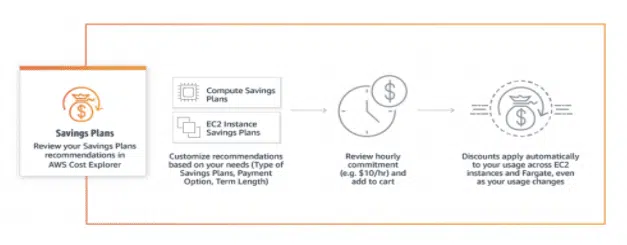
AWS Savings Plans vs. Reserved Instances
The following section highlights the key differences between traditional Reserved Instances and their new, more flexible counterpart, AWS Savings Plans.
Offering Types
| Unit | Reserved Instances | AWS Savings Plans |
|---|---|---|
| Types | Standard RIs and Convertible RIs | EC2 Instance Savings Plans and Compute Savings Plans |
| Commitment | One year or three years | One year or three years |
| Payment | All upfront, partial upfront, and no upfront | All upfront, partial upfront, and no upfront |
Discount & Coverage Comparisons
| Pricing Category | Standard RIs | Convertible RIs | EC2 Instance Savings Plans | Compute Savings Plans |
|---|---|---|---|---|
| Savings over On-Demand | Up to 72% | Up to 66% | Up to 72% | Up to 66% |
| Lower price for monetary commitment | No | No | Yes | Yes |
| Applies to any family | No | No | No | Yes |
| Applies to any size | No | No | Yes | Yes |
| Applies to any tenancy or OS | No | No | Yes | Yes |
| Applies to Fargate & Lambda usage | No | No | No | Yes |
| Applies across any AWS region | No | No | No | Yes |
| Offers 1- and 3-year terms | Yes | Yes | Yes | Yes |
Feature Comparisons
| Type of Feature | Standard RI | Convertible RI | EC2 Instance Savings Plan | Compute Savings Plan |
|---|---|---|---|---|
| Scope | Zonal (for Zonal RI) and Regional (for Regional RI) | Zonal (for Zonal RI) and Regional (for Regional RI) | Global | Global |
| Estimated cost reduction | Up to 72% | Up to 66% | Up to 72% | Up to 66% |
| Average discount for 1 year | 38% | 29% | 38% | 29% |
| Average discount for 3 years | 58% | 51% | 58% | 51% |
| Availability of 1 year tenure | Yes | Yes | Yes | Yes |
| Availability of 3 years tenure | Yes | Yes | Yes | Yes |
| Instance family flexibility | No | Yes (conditions apply) | No | Yes |
| Operating system flexibility | No | Yes | Yes | Yes |
| Regional flexibility | No | No | No | Yes (except China) |
| Tenancy flexibility | No | No | Yes | Yes |
| Payment options | All, Partial, No Upfront | All, Partial, No Upfront | All, Partial, No Upfront | All, Partial, No Upfront |
| Availability of capacity reservation | Yes | Yes | No | No |
| Applicability of account limits | Yes | Yes | No | No |
| Entitled to sell in the marketplace | Yes | No | No | No |
| Instance size flexibility | Yes, for Linux OS | Yes, for Linux OS using Exchange Reserved Instances API and console | Yes | Yes |
| Availability Zone flexibility | Yes, for Regional RI Linux OS using Modify Reserved Instances API and console | Yes, for Regional RI Linux OS using Exchange Reserved Instances API and console | Yes | Yes |
| List of Supported AWS services | EC2, RDS, Elastic Cache, DynamoDB, Redshift | EC2 | EC2 | EC2, Fargate, Lambda |
| Offload/Exchange Commitment | Sell under AWS Marketplace | Exchange for another instance size, family, OS, tenancy, term, or payment option | None | None |
Term Comparisons
| Unit | Reserved Instance | EC2 Instance Savings Plan | Compute Savings Plan |
|---|---|---|---|
| Average 1 Year Discount | 38% | 29% | 29% |
| Average 3 Year Discount | 58% | 58% | 51% |
| Instance Family | Fixed | Fixed | Flexible |
| Instance Size | Fixed (except Linux) | Flexible | Flexible |
| Geography | 1 Region | 1 Region | Flexible |
| OS | Fixed | Flexible | Flexible |
| Service | EC2 / RDS | EC2 | EC2 / Fargate |
Standard RI Flexibility Comparisons
| Type | Standard Regional RIs | Standard Zonal RIs | EC2 Instances Savings plans |
|---|---|---|---|
| Commitment Unit | Per instance | Per instance | Per Dollar |
| Geography | Region specific | Zone specific | Region specific |
| Instance Family | Fixed | Fixed | Fixed |
| Tenancy | Fixed | Fixed | Any tenancy |
| Operating System | Fixed | Fixed | Any OS |
Convertible RI Flexibility Comparisons
| Type | Convertible Regional RIs | Convertible Zonal RIs | AWS Compute Savings plans | |
|---|---|---|---|---|
| Commitment Unit | Per instance | Per instance | Per Dollar | |
| Geography | Region specific | Zone specific | Any region | |
| Instance Family | Exchangeable | Exchangeable | Any family | |
| Tenancy | Exchangeable | Exchangeable | Any tenancy | |
| Operating System | Exchangeable | Exchangeable | Any OS |
Reserved Instance and AWS Savings Plan Pricing
The following tables demonstrate savings for an M5 12xlarge EC2 instance across 1- and 3-year terms for Standard RIs, Convertible RIs, and AWS Savings Plans.
1 Year Standard Reserved Instance / 1 Year EC2 Instance Savings Plan
| Payment Option | Upfront | Monthly | Effective Hourly | Savings over On-Demand |
|---|---|---|---|---|
| No Upfront | $0.00 | $1,074.56 | $1.4720 | 36% |
| Partial Upfront | $6,140.00 | $511.73 | $1.4020 | 39% |
| All Upfront | $12,035.00 | $0.00 | $1.3740 | 40% |
1 Year Convertible Reserved Instance / 1 Year Compute Savings Plan
| Payment Option | Upfront | Monthly | Effective Hourly | Savings over On-Demand |
|---|---|---|---|---|
| No Upfront | $0.00 | $1,235.89 | $1.6930 | 27% |
| Partial Upfront | $7,061.00 | $588.38 | $1.6120 | 30% |
| All Upfront | $13,840.00 | $0.00 | $1.5800 | 31% |
3 Year Standard Reserved Instance / 3 Year EC2 Instance Savings Plan
| Payment Option | Upfront | Monthly | Effective Hourly | Savings over On-Demand |
|---|---|---|---|---|
| No Upfront | $0.00 | $741.68 | $1.0160 | 56% |
| Partial Upfront | $12,362.00 | $343.10 | $0.9400 | 59% |
| All Upfront | $23,241.00 | $0.00 | $0.8840 | 62% |
3 Year Convertible Reserved Instance / 3 Year Compute Savings Plan
| Payment Option | Upfront | Monthly | Effective Hourly | Savings over On-Demand |
|---|---|---|---|---|
| No Upfront | $0.00 | $852.64 | $1.1680 | 49% |
| Partial Upfront | $14,216.00 | $394.93 | $1.0820 | 53% |
| All Upfront | $27,864.00 | $0.00 | $1.0600 | 54% |
How to Purchase an AWS Savings Plan
- Review your AWS Savings Plan recommendations for your account.
- Consider your existing infrastructure needs (instance families, regional requirements) and any active RI commitments.
- Right-size your existing infrastructure if applicable.
- Determine what level of AWS Plan commitments you are comfortable with.
- Purchase your AWS Savings Plan commitments through the Purchase Savings Plan page.
- Monitor your commitments post-purchase to ensure maximum use while still avoiding On-Demand overages.

|
Platform
|
Multi Cloud Integrations
|
Cost Management
|
Security & Compliance
|
Provisioning Automation
|
Automated Discovery
|
Infrastructure Testing
|
Collaborative Exchange
|
|---|---|---|---|---|---|---|---|
|
CloudHealth
|
✔
|
✔
|
✔
|
||||
|
Morpheus
|
✔
|
✔
|
✔
|
||||
|
CloudBolt
|
✔
|
✔
|
✔
|
✔
|
✔
|
✔
|
✔
|
Understanding AWS Savings Plan Recommendations & Cost
You can view the recommendations for your AWS account through the console. There are three primary metrics to be aware of:
- Monthly On-Demand Spend: An estimated monthly cost of total usage without discounts over a selected period (including all active Savings Plans). This metric is used to illustrate effectiveness of your existing Savings Plans versus On-Demand usage.
- Estimated Monthly Spend: A monthly cost projection based on current commitment recommendations. This metric includes any forecasted On-Demand usage due to hour-to-hour variations.
- Estimated Monthly Savings: An estimated net savings for a selected period based on the current (unpurchased) commitment recommendations.
Monitoring AWS Savings Plans
Monitoring your usage is an essential part of managing your AWS Savings Plans. This helps you understand how discounts are applied and what usage types are covered under your Savings Plans. You can manage usage applicable to your Savings Plans in many ways, such as:
Via the Inventory: Shows a detailed overview of the Savings Plans you own or have queued for future purchases.
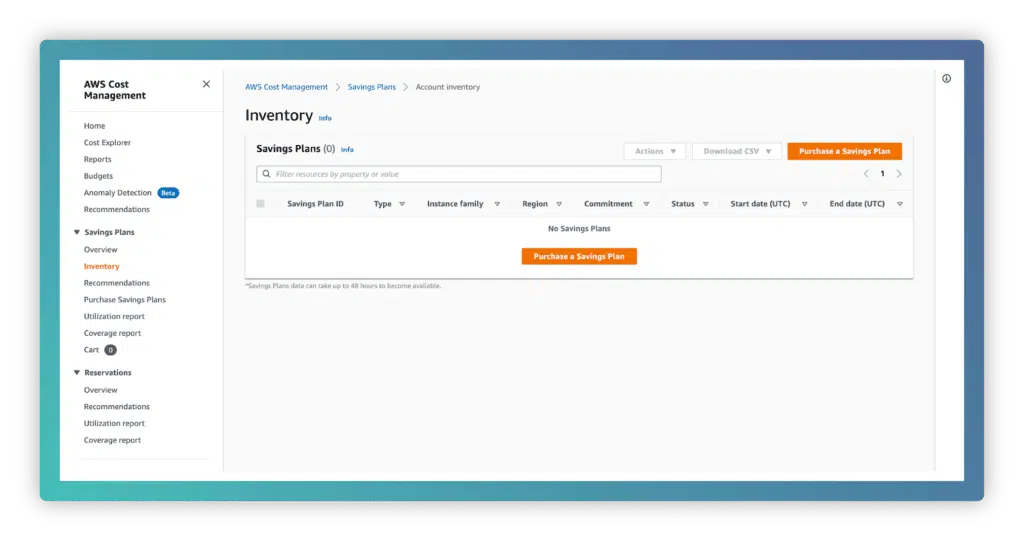
Via the Utilization report: Shows you the percentage of your Savings Plans commitment that you’re using across your computer usage.
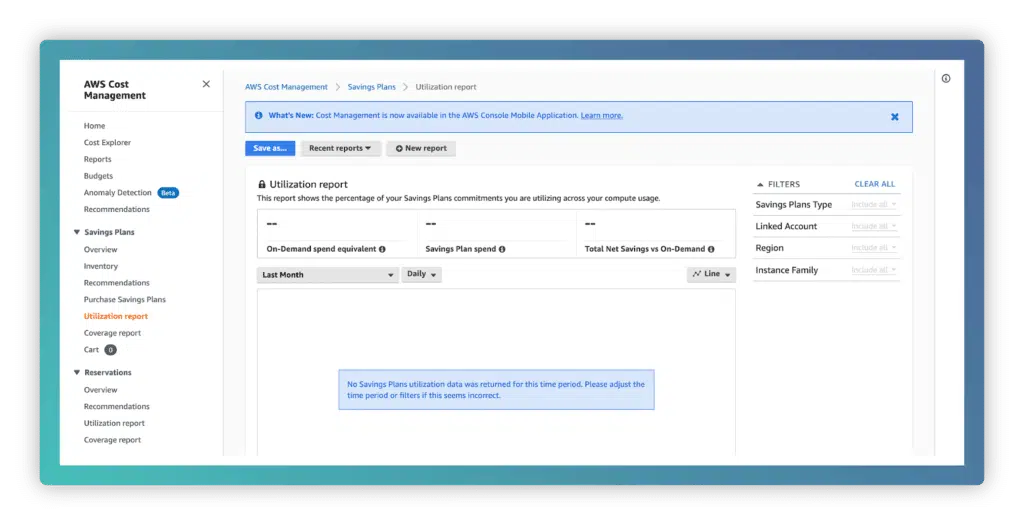
Via the Coverage report: Shows how much of your eligible spend was covered by your Savings Plans for a defined period.
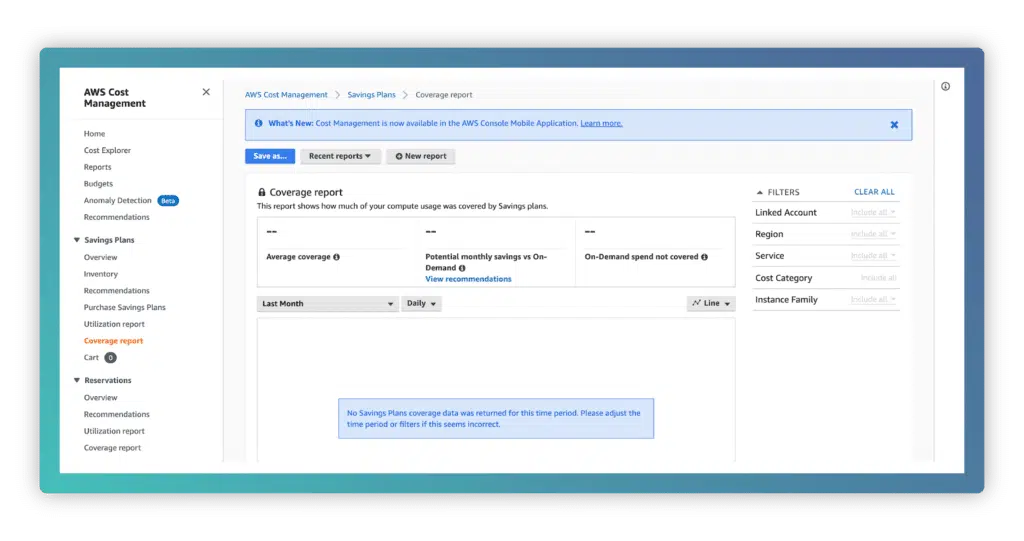
Via Budgets: Set budgets for your Savings Plan utilization, coverage, and costs.
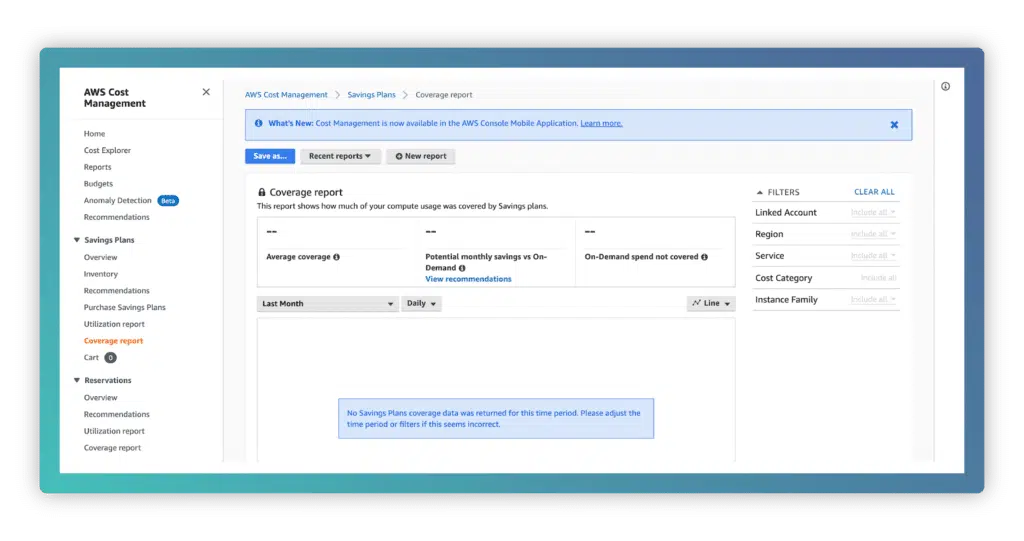
Advantages of AWS Savings Plans
- AWS Savings Plans don’t lock you into certain instance types like RIs, which means you can make changes within an instance family to be more cost-efficient.
- AWS Savings Plans can benefit from price changes that occur during your commitment, unlike RIs.
- AWS Savings Plans provide discounts without committing you to any specific instance type.
- AWS Savings Plans can be applied to Fargate as well as EC2 (but not RDS).
- AWS Savings Plans avoid the complexity of convertible RI exchanges.
- AWS Savings Plans require less infrastructure planning.
- AWS Savings Plans allow you to flexibly transfer workloads between instance types, sizes, and generations to meet changing demand and architecture.
Limitations of AWS Saving Plans
- AWS Savings Plans can’t be purchased for RDS, Redshift, and other services.
- AWS Savings Plans don’t offer reseller opportunities to offload underutilized commitments.
- AWS Savings Plans charge On-Demand prices for overages.
- AWS Savings Plans don’t provide capacity reservations.
- AWS Savings Plans don’t often provide better discounts compared to RIs.
Advantage of AWS Reserved Instances over AWS Savings Plans
- RIs for shorter terms can be purchased on the marketplace.
- RIs can include discounts for RDS, as well as EC2 (but not Fargate).
- RIs can provide some of the largest discounts on the higher-end (60% or more) in the case of some 3-year upfront terms.
Using Reserved Instances and AWS Saving Plans Together
Purchasing an AWS Savings Plan doesn’t free you from following cost optimization strategies. Many consumers who plan on using AWS Savings Plan have already purchased Resource Instances for lower prices. Trying to abandon your RIs by selling them all and buying a Savings Plan isn’t an ideal solution for your budget; conversely, having a portfolio of just Reserved Instances often lacks the flexibility your business needs. Using both models balances more significant discounts with long-term flexibility.
By using RIs as a layer on top of your AWS Savings Plan, you have a backup discount program that can reduce cloud costs until the expiration of your reservations. If you have predictable resources that aren’t covered by RIs, applying an AWS Savings Plan on them can be a safe option.
Related Blogs

The End of Manual Optimization: Why We Acquired StormForge
Today is a big day for CloudBolt—we’ve officially announced our acquisition of StormForge. This marks a major milestone for us…



